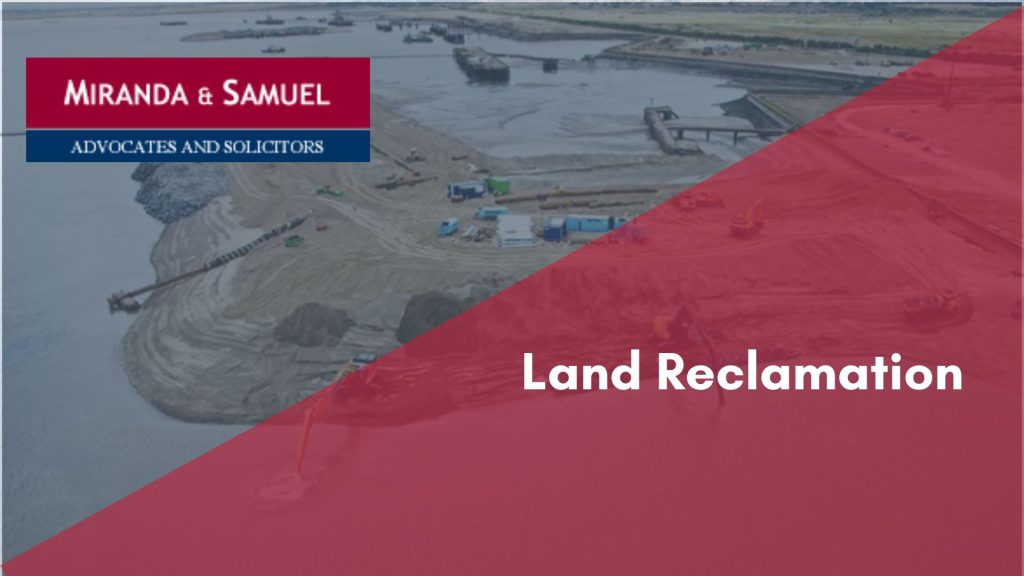Land Reclamation is the process of creating new land from oceans, seas, riverbeds or lake beds. It is one of the most sought-after mega-development projects in the region. In Malaysia, there are famous well-known land reclamation projects such as the creation of a new island in the Strait of Malacca and the Penang South Island.
Land reclamation projects in Malaysia requires the navigation of a complex web of laws, regulations, and approval processes at the federal, state, and local levels. Proper due diligence, stakeholder engagement, and adherence to legal requirements are crucial for the successful implementation of such projects.
There are basically two types of land reclamation, the island type and the peninsular type. The island type of land reclamation is in the form of a reclaimed artificial island detached from the existing shoreline whereas peninsular land reclamation is a shore-connected reclamation.
However, while the reclamation projects bring economic benefits such as an increase in the area of usable land for economic, social and governmental activities and use as satellite areas of nearby urban centres, they also result in coastal erosion, water pollution, destruction to the biodiversity and the livelihoods of local fishers.
Thus, to ensure that the land reclamation projects are carried out sustainably and properly balance the pros and cons, several measures have been introduced by the Government.
–
Governing Acts and Regulations
1. Environmental Quality Act 1974 (revised 1987)
Under the Act, the submission of Environmental Impact Assessment reports is mandatory for prior approval of the Department of Environment (DOE) if the land reclamation involving more than 50 hectares is captured under Activity 4 of Environmental Quality (Prescribed Activities) (Environmental Impact Assessment) Order 1987. Activity 11 (c) of the Act also includes sand mining activity involving more than 50 hectares where it states that such projects must secure approval from the local authorities and state authorities to ensure that the projects are in compliance with the local regulation.
2. General Administrative Circular No. 5 of 1987
All proposed development projects in the coastal zone including land reclamation and sand mining are required to be referred to the Coastal Engineering Technical Center (CETC) of the Coastal Engineering Division at the Department of Irrigation and Drainage (DID) for comments.
3. Guidelines on erosion control for development projects in the coastal zone
The guidelines are to assist in processing applications for development by the General Administrative Circular No. 5 of 1987. Also, the guidelines are to ensure proper planning and implementation of coastal development projects for sustainable development in line with the directions stipulated in the erosion control management plan of the National Coastal Resources Management Policy.
It is provided in the guidelines that all land reclamation projects irrespective of whether an Environmental Impact Assessment is required or not, should be subjected to impact evaluation which captures the hydrodynamics and morphological changes using a modelling approach. This is to evaluate whether there are any adverse impacts caused by the land reclamation and if so, the developer is required to take feasible mitigative measures. Also, there should be proper provisions for the discharge of the drainage or flood flows from the hinterland. As for the setback limits, there should be a setback of 60 meters measured from the landward edge of the landward edge of the Mean High Water Spring. However, if coastal erosion protection works are provided, the developer needs to provide a sufficient setback to be agreed upon by the CETC for the maintenance of the structures. This setback zone should also be equipped with a service road built by the developer for public access to sea frontage.
Whereas, for sand mining activities, as a general rule, sand mining is not permitted in nearshore areas which are less than 1.5 km from the Mean Low Water Line or 10 meters water depth (from the Lowest Astronomical Tide) whichever is further from the shore. This is to ensure that this will not result in any major disruption to the delicate balance of sediment movement in the nearshore littoral cell.
However, if it is not possible to comply with the above requirement due to technical, practical or economic reasons, a hydraulic study should be conducted to ensure that the sand mining activity at the proposed site would not lead to adverse impacts on the coastal processes, aquatic eco-systems and the stability of the adjacent shorelines. It should be noted that if there is an existing study which shows that any sand mining activity in a particular area will have adverse impacts, all mining activities in these sensitive areas shall be prohibited despite the general guidelines for sand mining being adhered to.
Application for Land Reclamation Projects
Under the Federal Constitution, land is a state matter and hence all reclamation projects require the approval of the State Government before they can be implemented. All land, including the foreshore up to 3 nautical miles seaward from the low-water mark, is controlled by the state. The seabed and water beyond this limit, up to the continental shelf boundary, falls under federal jurisdiction.
Therefore, any application for land reclamation must first be submitted to the Local Authority or State Government for reviews and comments from the various Government Agencies. If the location of the sand mining area is within 3 nautical mile limit, the application would then require approval from the State EXCO. Otherwise, it would require the Ministry of Land and Cooperative Development’s approval.
Conclusion
Addressing these legal issues requires thorough legal due diligence, proactive risk management, compliance with regulatory requirements, and engagement with stakeholders and affected communities throughout the project lifecycle.
While land reclamation may offer numerous economic advantages, every reclamation project must be approached with due consideration and adherence to legal regulations to mitigate potential damage to the communities and ecosystems.
– By George Miranda, Joy Sam Jia Qian, Kong Chai Yin –
This article is for general information purposes only and does not constitute legal or professional advice. It should not be used as a substitute for legal advice relating to your particular circumstances. Please note that the law may have changed since the date of this article.





